Music Information Retrieval
Opportunities for digital musicology
November 2023 - GhentJoren Six
Who?
- Studied computer science
- Researcher at Ghent Conservatory
- Phd at IPEM Engineering Systematic Musicology
-
Involved as Post Doc:
- Nano4Sports Low impact runner
- CONBOTS COnnected throug roBOTS
- AMPLE the Augmented Movement Platform for Embodied Learning
- PaPiOM Patterns in Pitch Organization in Music
- Now at Ghent Center for Digital Humanities

What?
-
Music Information Retrieval
- Introduction
- Music information - Tasks
- Methods - Tools
-
Pitch organisation: PaPiOM
- Introduction
- Music information
- Methods
- Case study
-
Duplicate detection
- Introduction
- Music information
- Methods
- Applications
MIR introduction
Goal
An overview of the Music Information Retrieval research field while focusing on opportunities for digital musicology.
MIR introduction
Definition
Music Information Retrieval is the interdisciplinary science of extracting and processing information from music.
MIR combines insights from musicology, computer science, library sciences, psychology, machine learning and cognitive sciences.
MIR introduction
MIR tasks process information on music. Music information can be captured by signals or symbols.Definition
Signals are representations of analog manifestations and replicate perception. Symbols are discretized, limited and replicate content.
Music information
Signal
- Recorded performances
- Video
- Audio
- Motion capture
- MIDI
- Scans of scores
Symbols
- Meta-data
- Artist
- Title
- Album-name
- Label
- Composer
- Instrumentation ...
- Lyrics
- Rags, reviews, ratings
- Digitized scores
Music information
Scan
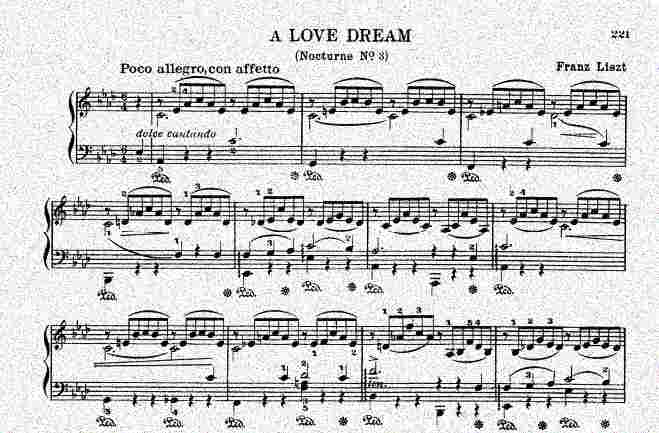 Fig: Scanned score
Fig: Scanned score
Music information: Signal or symbol?
Signal or symbol? | |
| Video | |
| MIDI | |
| Recorded MIDI | |
| Arthur Rubinstein | |
| Daniel Barenboim | |
Music information
A score can be seen as a model of a performance.
Models aim to reduce dimensions, complexity and improve understanding and readability.Quote
"Essentially, all models are wrong, but some are useful"
- George E.P. Box
MIR tasks: music transcription
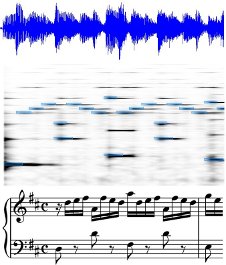
Fig: music transcription
- Source separation
- Instrument recognition
- Pitch estimation and segmentation
- Tempo and rhythm extraction
Task type: signal → symbolic
MIR tasks: structural analysis

Fig: structural analysis
Task type: signal → symbolic
MIR tasks: music recommendation

Fig: Spotify automatically generates playlists based on listening behaviour
Music recommendation
- Content based: signal → symbolic
- Based on (listening) behaviour: symbolic → symbolic
MIR tasks: other tasks
- Score following: page turning based on musical content
- Music emotion recognition
- Automatic cover song identification
- Optical music recognition: convert images of scores into digital scores
- Symbolic music retrieval
- Automatic genre recognition
MIR Tasks
Most tasks enable to browse, categorize, query or discover music in large databases of music.
MIR tasks: ± Solved
-
Monophonic pitch estimation
De Cheveigné, A., & Kawahara, H. (2002). YIN, a fundamental frequency estimator for speech and music. The Journal of the Acoustical Society of America, 111(4), 1917-1930.
-
Content based audio search
Six, J., & Leman, M. (2014). Panako: a scalable acoustic fingerprinting system handling time-scale and pitch modification. In 15th International Society for Music Information Retrieval Conference (ISMIR-2014).
MIR tasks: challenges
Un-mix the mix
Decomposing a mixed audio signal is very very hard.

Fig: Mixing is easy,...

unmixing?
MIR tasks: challenges
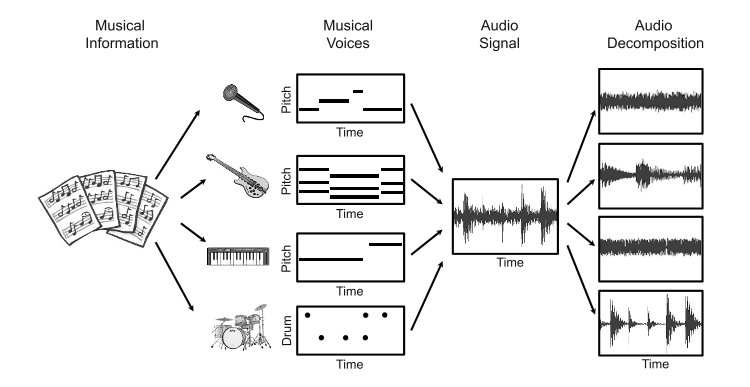
MIR Methods - Bag of features

MIR Methods - Bag of features
Bag of features and classifier to represent e.g. a musical genre.- MFCC, timbral characteristic
- Spectral centroid
- Spectral moment
- Zero crossing rate
- Number of low energy frames
- Autocorrelation lag
- ....
MIR Methods - Data based
System learns a solution from (many) correct examples.- Denoising
- Decomposition
- Transcription
- Genre detection
- AI-music generation
- ....
MIR Tools - Sonic visualiser
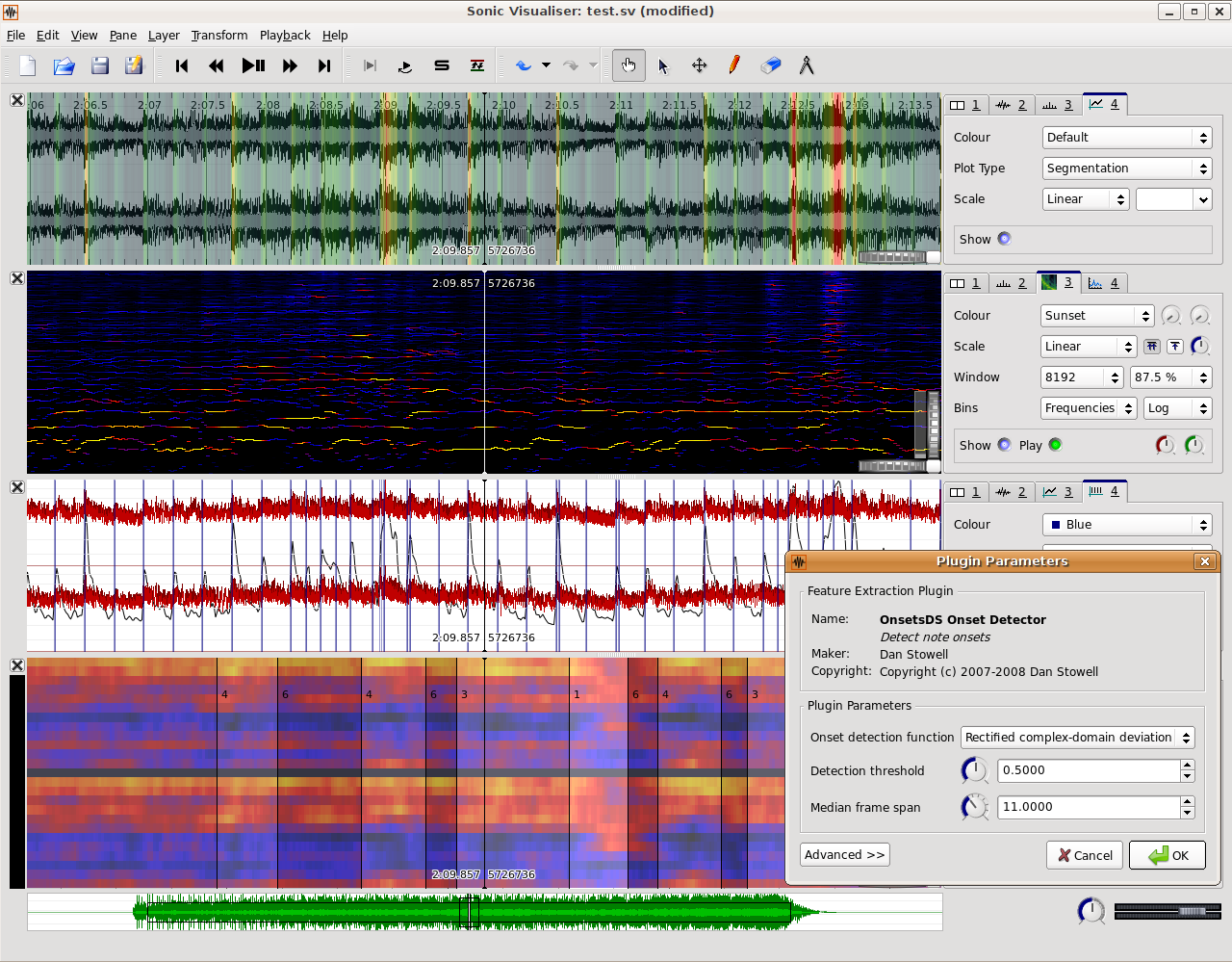
Sonic Visualiser is an application for viewing and analyzing the contents of audio files. It has support for:
Sonic visualiser
- Beat tracking
- Cord estimation
- Melody detection
- Onset detection
- Annotations
Sonic visualiser
MIR Tools - Tartini
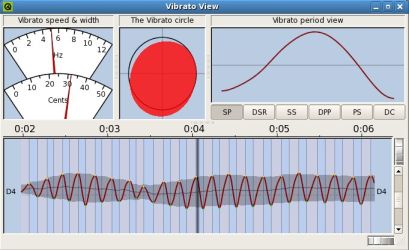
MIR Tools - Music 21
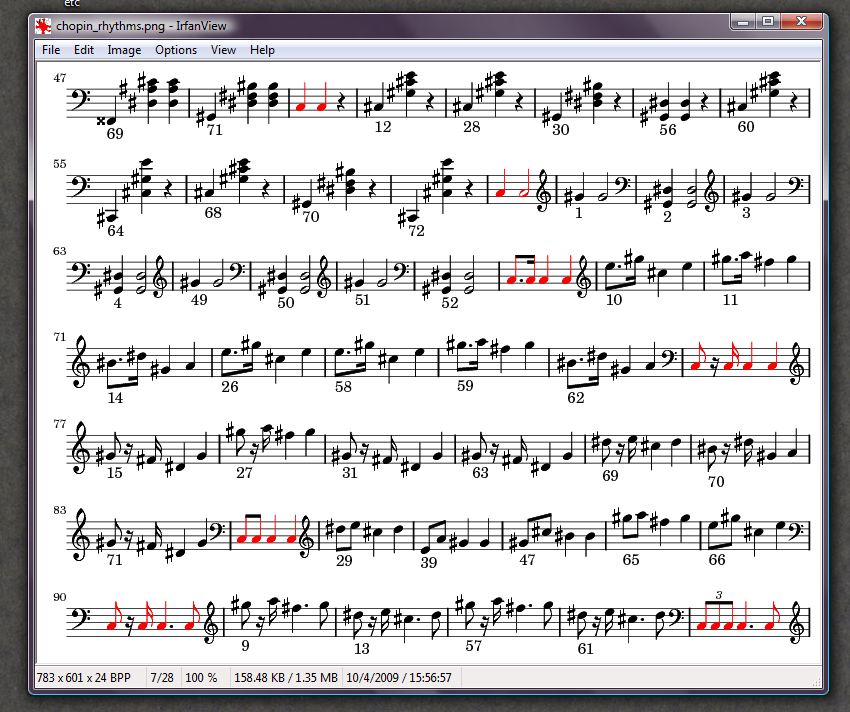
A programming environment for symbolic music analysis
Music21
- Query rhythmic features
- Melodic contours
- Chord progressions
Music21
MIR Tools - MusicLM: Generating Music From Text
| Caption | Generated audio |
|---|---|
| The main soundtrack of an arcade game. It is fast-paced and upbeat, with a catchy electric guitar riff. The music is repetitive and easy to remember, but with unexpected sounds, like cymbal crashes or drum rolls. | |
| A fusion of reggaeton and electronic dance music, with a spacey, otherworldly sound. Induces the experience of being lost in space, and the music would be designed to evoke a sense of wonder and awe, while being danceable. | |
| A rising synth is playing an arpeggio with a lot of reverb. It is backed by pads, sub bass line and soft drums. This song is full of synth sounds creating a soothing and adventurous atmosphere. It may be playing at a festival during two songs for a buildup. | |
| Slow tempo, bass-and-drums-led reggae song. Sustained electric guitar. High-pitched bongos with ringing tones. Vocals are relaxed with a laid-back feel, very expressive. |
MIR Tools - Audio Denoising
Noisy input |
Denoised |
 |
 |
MIR tools - Apple Music Sing

MIR tools - Moises.ai - Tools for musicians
MIR Methods - Problems
MIR research is often limited by (over?) simplification:- MIR focuses mainly on classical western art music or popular music with ethnocentric terminology like scores, chords, tone scale, chromagrams, instrumentation, rhythmical structures.
- It is mainly goal oriented and pragmatic (MIREX) without explaining processes. More engineering than science?
- Unclear which features correlate with which cognitive processes.
- It is mainly concerned with a limited, disembodied view on music: disregarding social interaction, movement, dance, the body, individual or cultural preferences.
MIR Methods - Problems
Quote
Essentially, all MIR-research is wrong, but some is useful
PART II
PaPiOM
Patterns in Pitch Organization in Music
PaPiOM: Introduction
Patterns
“Patterns are fundamental in music around the world”
Why study cross-cultural patterns in music?
- Origins of music
- Evolution of music
- Non-human musicality
- Nature-nurture debates
- Definition of music
Bod, R. (2013). Who's afraid of Patterns?: The Particular versus the Universal and the Meaning of Humanities 3.0. BMGN-Low Countries Historical Review, 128(4), 171-180.
PaPiOM: Introduction
Action and Perception
- Context-poor
- Data-poor
- Controlled
- Many studies
Corpora
- Context-rich
- Data-rich
- Wild
- Few large scale
Repp, B. H. (2005). Sensorimotor synchronization: a review of the tapping literature. Psychonomic bulletin & review, 12(6), 969-992.
Panteli, M., Benetos, E., & Dixon, S. (2018). A review of manual and computational approaches for the study of world music corpora. Journal of New Music Research, 47(2), 176-189.
PaPiOM: Introduction
Goal
PaPiOM: perform large-scale corpus-based studies to identify patterns in pitch use in music. Link corpus-based findings with other findings.
Study of patterns in music
Potential patterns common in music around the world:- Distinctness of pitches
- Octave equivalence
- Number of pitch classes
- Intervals between pitch classes
PaPiOM: Introduction
PaPiOM: Music Information
Starting from a recording we need a semi-automated way to extract:- Main pitch contour
- Pitch Class Set (scale)
- Meta-data: recording place, date, people, language, ...
Methods: pitch tracking
Methods: pitch tracking
Methods: pitch tracking - Pitch Class?
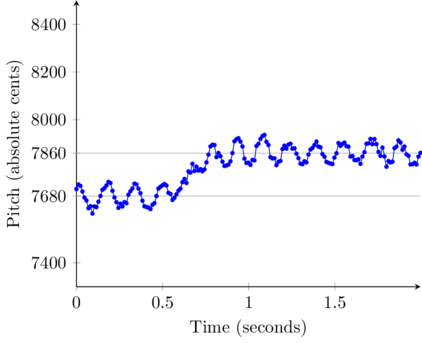
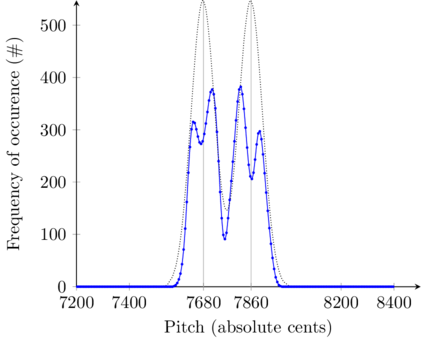
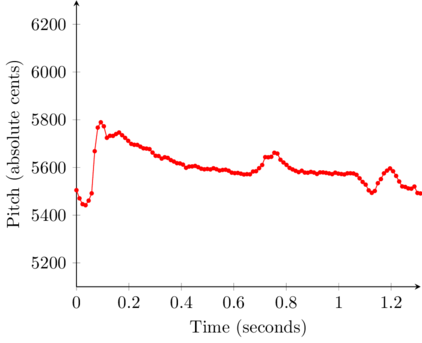
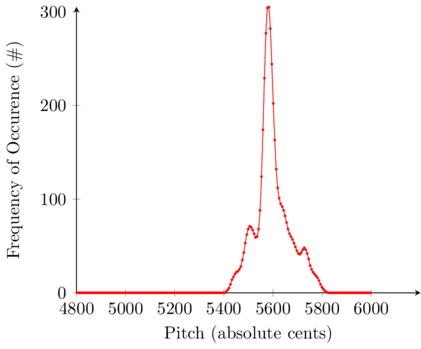
Methods: pitch tracking - Pitch Class?
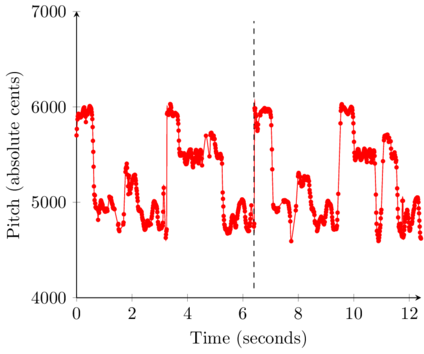
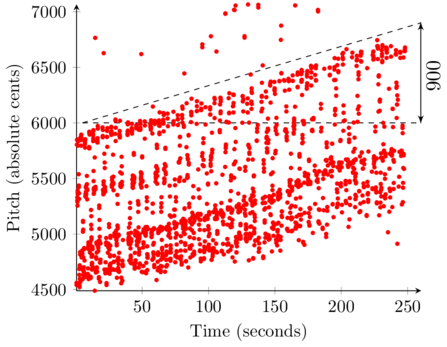
PaPiOM: Case study - Wax Cylinder Recordings
- Culturally diverse
- Geographically spread
- 'Uninfluenced'
- Noisy
- Short
- Unbalanced

Fig: Wax Cylinders, most poplar around 1896–1916 with a capacity of about 2 minutes.
PaPiOM: Case study - Wax Cylinder Recordings
IU - K.E. Laman, 1911, French Equatorial
IU - G. Herzog, 1930, Liberia
RMCA - P. Tempels, 1944, RDC
RMCA - P. Tempels, 1944, RDC - Denoised
Moliner, E., & Välimäki, V. (2022, May). A two-stage u-net for high-fidelity denoising of historical recordings. ICASSP 2022-2022. IEEE.
PaPiOM: Case study - Wax Cylinder Recordings
- The concept of pitch class is present
- 170 or 240 cents as building blocks
- 2 to 8 pitch classes
- Fifth is almost always present.
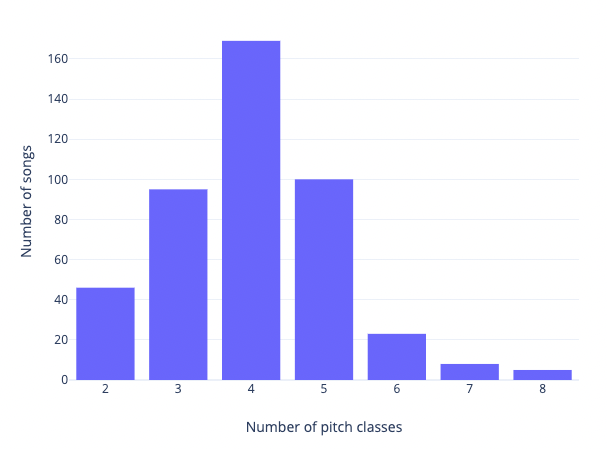 Fig: The number of songs for each pitch class set size.
Fig: The number of songs for each pitch class set size.
PaPiOM: Case study - Wax Cylinder Recordings
 Fig: Pitch intervals between all pitch classes for recordings with 5 identified pitch classes.
Fig: Pitch intervals between all pitch classes for recordings with 5 identified pitch classes.
PaPiOM: Case study - Wax Cylinder Recordings
 Fig: Pitch intervals between all pitch classes for recordings with 4 identified pitch classes.
Fig: Pitch intervals between all pitch classes for recordings with 4 identified pitch classes.
PaPiOM: Case study - Wax Cylinder Recordings
- Bias: selection or recording technology
- Analysis assumes octave equivalence (498 = 702)
- Absolute pitch unclear
- Timbre ignored
- Unbalanced dataset
- Release dataset without audio
- Separating scale origins difficult
- perception
- production
- information content minimization
- transmission
PaPiOM: Summary
- MIR task: find patterns in pitch use
- Music information: signal to symbolic pitch classes
- Feature based method: pitch tracking and processing
- Case study: 400 historic recordings reveal patterns
PART III
Duplicate detection for digital musicology
Duplicate detection: Introduction
What if we have an easy way to detect duplicate audio?
Duplicate detection: Introduction

Duplicate detection: introduction

Duplicate detection: Music Information

Duplicate detection: methods
Duplicate detection: Music Information
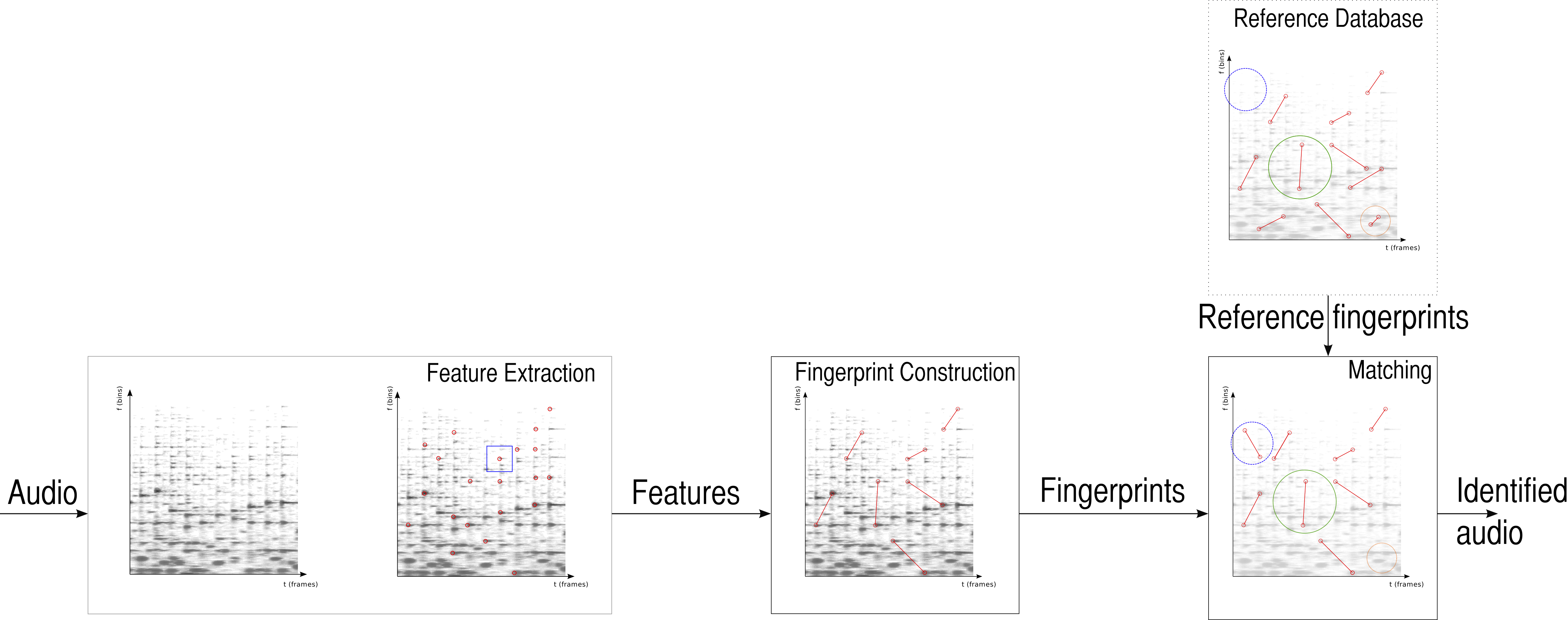
Duplicate detection: Applications - Musical structure
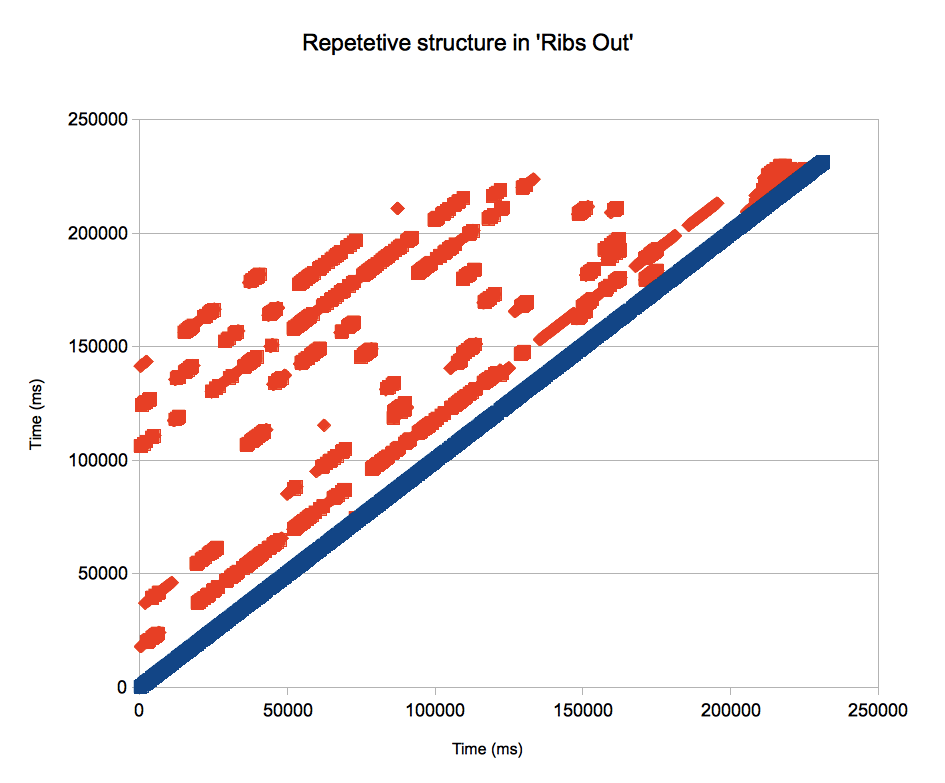
Duplicate detection: Applications - Exact repetition in music
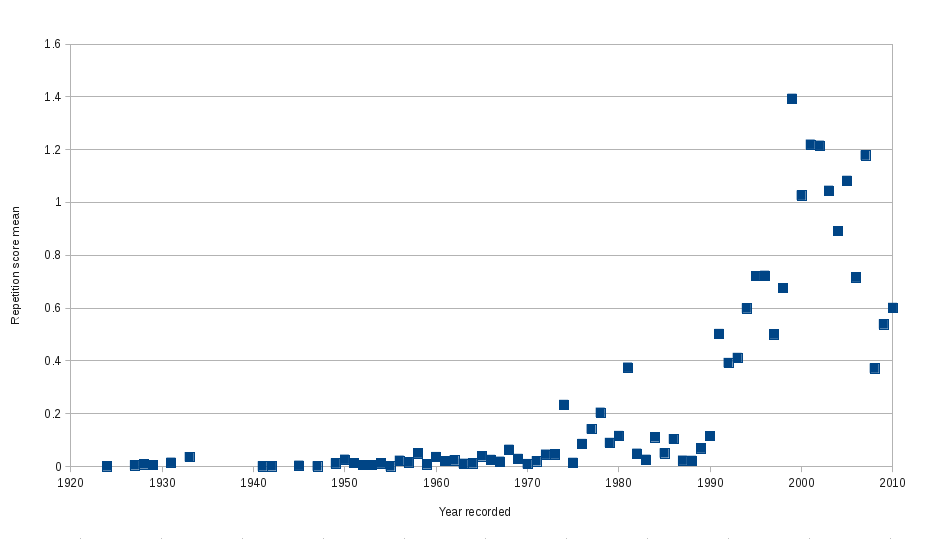
Duplicate detection: versions
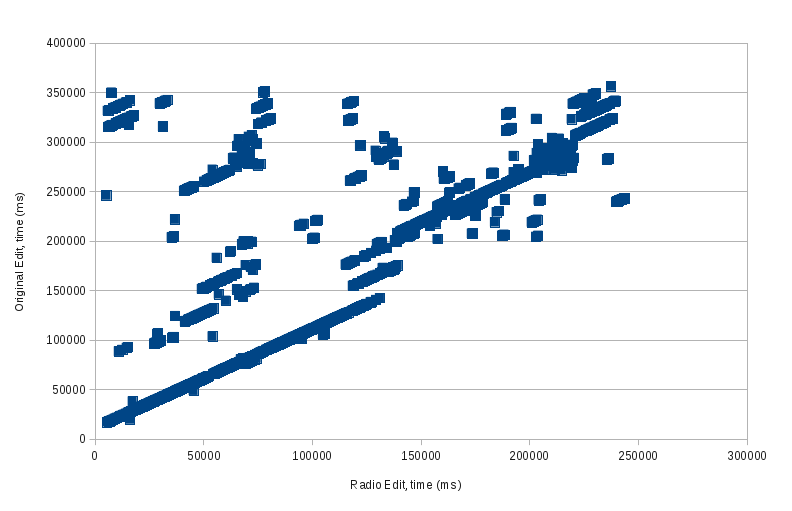
Duplicate detection: Applications - DJ-set analysis
Duplicates after time-stretching, pitch-shifting and tempo change:
- Which parts of which songs were played and for how long
- Which modifications were applied (percentage modification of time and frequency)
Duplicate detection: Applications - Compare meta-data


Duplicate detection: Applications - Twins
| First twin | Second twin | |
|---|---|---|
| Audio | ||
| Year recorded | ? | 1949 |
| Title | The daughter Mandega | ? |
| People | Zezuru | Shona / Zezuru |
| Collector | Hugh Tracey | Hugh Tracey |
Duplicate detection: Applications - Merge digital music archives

Duplicate detection: Applications - Improve listening experiences

Duplicate detection: Applications - Re-use segmentation

Duplicate detection: Summary
- MIR task: find duplicate audio
- Music information: signal to symbolic, searchable fingerprints
- Feature based method: spectral peaks
- Many applications
General Summary
- MIR is the interdisciplinary science of extracting and processing information from music.
- Symbols and signals encode musical information.
- MIR offers opportunities for innovative (large scale) digital musicology and find patterns in music.
- Duplicate detection has many applications and can use spectral information to identify matches between audio.